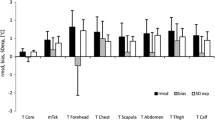Abstract
Body temperature is one of the vital indicators that reflects the human body health. It is used to diagnose different types of diseases. Generally, there are two types of body temperatures: the skin and core temperature. The body temperature is used to diagnose some diseases by assessing its abnormality. The core temperature is primarily used for diagnosis as a clear standard is available. However, core temperature measurement requires minutes and places a strain on the subjects, whereas the skin temperature can be monitored real time and measured without contact. Because the skin temperature is affected by many factors, a definite standard to assess its abnormality does not exist. Herein, we propose a prediction method for the skin temperature based on machine learning. Each estimator of the machine learning is generated in restricted conditions to limit the factors handled by machine learning at once. The root mean square error of the prediction is 0.315 ℃, and the root mean square percentage error is 0.90%. The prediction result can be used as a standard for the anomaly detection of the skin temperature.






Similar content being viewed by others
References
Caldeira JMLP, Moutinho JAF, Vaidya B, Lorenz P, Rodrigues JJPC (2010) Intra-body temperature monitoring using a biofeedback solution. In: Proceedings of the second international conference on eHealth, telemedicine, and social medicine, Feb 2010, pp. 119–124
Boano CA, Lasagni M, Rmer K, Lange T (2011) Accurate temperature measurements for medical research using body sensor networks. In: Proceedings of the 14th IEEE international symposium on object/component/service-oriented real-time distributed computing workshops, Mar 2011, pp. 189–198
Yu C, Haijun Z, Na W (2008) Body temperature monitor and alarm system used in hospital based on 1-wire and wireless communication technology. In: Proceedings of the 2008 international workshop on education technology and training & 2008 international workshop on geoscience and remote sensing, Dec 2008, pp. 401–404
Ito H, Oiwa K, Nozawa A (2018) Face tracking based on temperature distribution of thermal images for real-time psychophysiological states evaluation using facial skin temperature. In: Proceedings of the 2018 international conference on intelligent informatics and biomedical sciences, Oct 2018, pp. 6–7
Urashima A, Li S, Toriyama T, Matsumoto M, Mori T, Iketani K, Sumitani Y (2016) Preliminary study of thermography-combined home monitoring system for single-living elderly. IEICE Tech Rep WIT2016-47 116(360):11–16 (in Japanese)
Hagberg K, Branemark R (2001) Consequences of non-vascular transfemoral amputation: a survey of quality of life, prosthetic use and problems. Prosthet Orthot Int 25(3):186–194
Mathur N, Glesk I, Buis A (2016) Skin temperature prediction in lower limb prostheses. IEEE J Biomed Health Inform 20(1):158–165
Peery JT, Klute GK, Blevins JJ, Ledoux WR (2006) A three-dimensional finite element model of the transibial residual limb and prosthetic socket to predict skin temperatures. IEEE Trans Neural Syst Rehabil Eng 14(3):336–343
Hussain Z, Sheng M, Zhang WE (2019) Different approaches for human activity recognition: a survey. CoRR abs/19060.5074:1–28
Aggarwal J, Ryoo M (2011) Human activity analysis: a review. ACM Comput Surv 43(3):16:1–16:43
Gagge A (1971) An effective temperature scale based on a simple model of human physiological regulatory response. ASHRAE Trans 77(2192):247–262
Stolwijk JA (1971) A mathematical model of physiological temperature regulation in man. Natl Aeronaut Space Admin 1855(NAS 9–9531)
Tanabe S, Kobayashi K, Nakano J, Ozeki Y, Konishi M (2002) Evaluation of thermal comfort using combined multi-node thermoregulation (65mn) and radiation models and computational fluid dynamics (cfd). Energy Build 34(6):637–646
Hamatani T, Uchiyama A, Higashino T (2015) Estimating core body temperature based on human thermal model using wearable sensors. Proceedings of the 30th ACM/SIGAPP symposium on applied computing (SAC 2015), pp. 521–526
Uchiyama A, Hamatani T, Higashino T (2015) Estimation of core temperature based on a human thermal model using a wearable sensor. Proceedings of 2015 IEEE 4th global conference on consumer electronics (GCCE), pp. 605–609
Kingma DP, Ba JL (2015) Adam: a method for stochastic optimization. 3rd International conference on learning representations (ICLR), arXiv:1412.6980
Epstein Y, Yanovich R (2019) Heatstroke. N Engl J Med 380(25):2449–2459
Brown DJA, Brugger H, Boyd J, Paal P (2012) Accidental hypothermia. N Engl J Med 367(20):1930–1938
Pryor JA, Prasad AS (2008) Physiotherapy for respiratory and cardiac problems: adults and paediatrics. Elsevier Health Sciences, Amsterdam
Author information
Authors and Affiliations
Corresponding author
Additional information
Publisher's Note
Springer Nature remains neutral with regard to jurisdictional claims in published maps and institutional affiliations.
About this article
Cite this article
Morishima, S., Xu, Y., Urashima, A. et al. Human body skin temperature prediction based on machine learning. Artif Life Robotics 26, 103–108 (2021). https://doi.org/10.1007/s10015-020-00632-4
Received:
Accepted:
Published:
Issue Date:
DOI: https://doi.org/10.1007/s10015-020-00632-4




